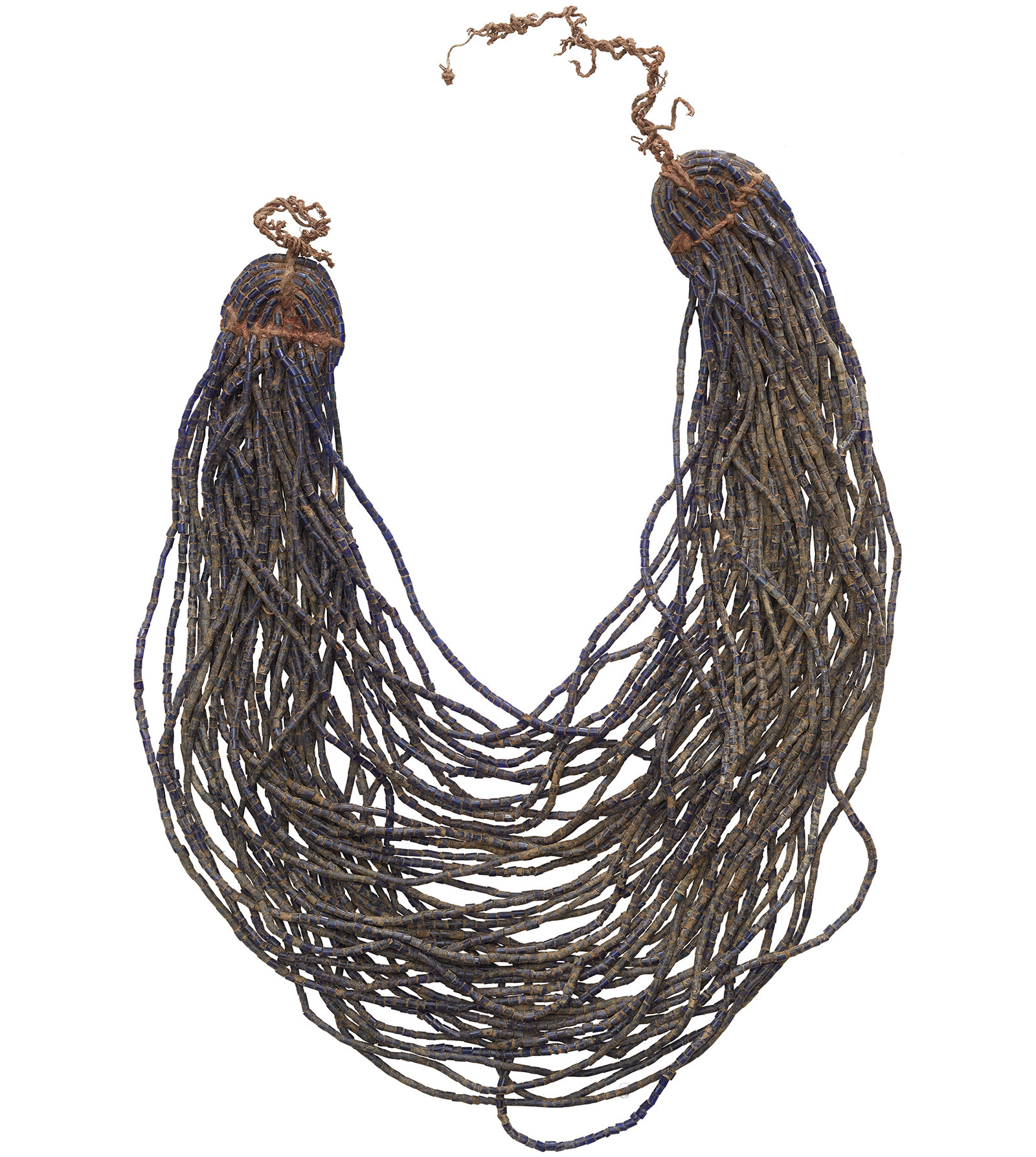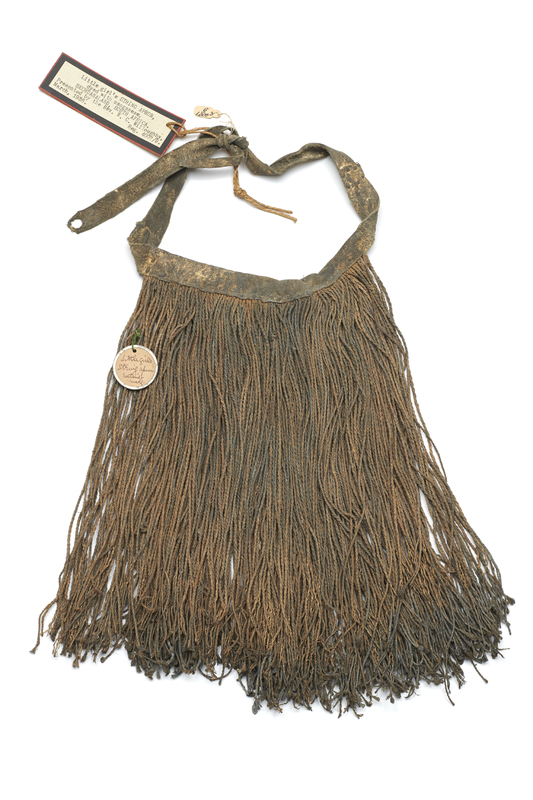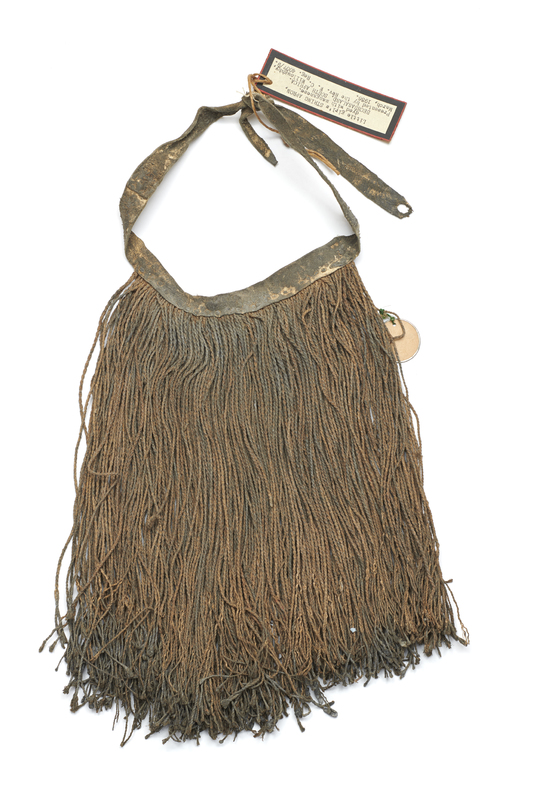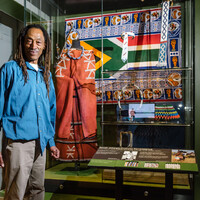String Apron; Makgabe
Item
Title
String Apron; Makgabe
Creator
Unrecorded
Description
Physical Description: String apron consisting of a fringe of closely tied plaited strings attached to a hide belt.
[Royal Pavilion & Museums]
[Royal Pavilion & Museums]
Contextual Description: [00:48:03] For girls they’ll start wearing something like this. And he said back in the days they would wear this up until they are older, like young women with their fully developed breasts.
He says It was only after the elders realised that she is now a woman – and what would be the first indication? The first menstruation. And what will follow that? Rite of passage where she will be like taught now you are no longer a girl, you are now a woman and this is what it will mean…and then she will move from wearing this to the two aprons the front and the back aprons. He went on to say that the breasts would be left bare. People never usually wear anything up there [gestures to chest]
[Transcription by KL of MAC_BB_20190817_RPM3 interview with Tshupo Ntono [Scobie Lekhutile's translation from Tswana, 2019]
He says It was only after the elders realised that she is now a woman – and what would be the first indication? The first menstruation. And what will follow that? Rite of passage where she will be like taught now you are no longer a girl, you are now a woman and this is what it will mean…and then she will move from wearing this to the two aprons the front and the back aprons. He went on to say that the breasts would be left bare. People never usually wear anything up there [gestures to chest]
[Transcription by KL of MAC_BB_20190817_RPM3 interview with Tshupo Ntono [Scobie Lekhutile's translation from Tswana, 2019]
Contextual Description: SL 13:47 This here, okay. You're surprising me as women, Batswana women, our, our way was that a girls grew and grew and will still be a girl up until that time when now you are old enough to marry that's when you be moving from the girls attire to what is known as a women's attire. So to avoid anything ... there would be a you know, typical as a little girl you wear makgabe and then it becomes like... they'll be looking at that, you know, your breasts are growing so they give you longer makgabe you should know that.
[Scobie Lekhutile, transcript of interview MAC_BB_20190805_NS1, 2019]
[Scobie Lekhutile, transcript of interview MAC_BB_20190805_NS1, 2019]
Contextual Description: Makgabe is an accepted word for a string skirt that can be decorated with beads, but root word kgabisa means to accessorise. TS comments
Contextual Description: JM 15:14So this is the same.
SL 15:16
magkabe So
JM 15:18
what do we what are we calling this a skirt again? a front skirt?
SL 15:22
What is it called?
WT 15:23
Magkabe. Normally it is not front. It's just covers the whole oh no but for young girls also it could cover the front. It could cover the front.
SL 15:34
Can we borrow from Your people and call it a kilt of some sort
JM 15:46
But a kilt goes all the way around
WT 15:53
What is written there?
JM 15:57
Little girl's apron They've got the little girl. Yeah, well, you're saying towards puberty and
WT 16:04
to the little girl... Didn't matter. Just covering the part and leaving the other...
The above notes are from a transcription by Kathleen Lawther of a discussion between Gase Kediseng, JoAnn McGregor, Nicola Stylianou, Scobie Lekhuthile and Winani Thebele which took place at the Khama III Memorial Museum on the 5th of August 2019. To listen to the full recording please follow the link below.
SL 15:16
magkabe So
JM 15:18
what do we what are we calling this a skirt again? a front skirt?
SL 15:22
What is it called?
WT 15:23
Magkabe. Normally it is not front. It's just covers the whole oh no but for young girls also it could cover the front. It could cover the front.
SL 15:34
Can we borrow from Your people and call it a kilt of some sort
JM 15:46
But a kilt goes all the way around
WT 15:53
What is written there?
JM 15:57
Little girl's apron They've got the little girl. Yeah, well, you're saying towards puberty and
WT 16:04
to the little girl... Didn't matter. Just covering the part and leaving the other...
The above notes are from a transcription by Kathleen Lawther of a discussion between Gase Kediseng, JoAnn McGregor, Nicola Stylianou, Scobie Lekhuthile and Winani Thebele which took place at the Khama III Memorial Museum on the 5th of August 2019. To listen to the full recording please follow the link below.
Publisher
Making African Connections
Date
Pre 1899
Type
PhysicalObject
Format
Whole: 330 mm x 235 mm x 40 mm
Fibre; Animal skin; Manganese
Identifier
R4007/9
Source
Collected by Reverend William Charles Willoughby, a Christian missionary, in what was then the Bechuanaland Protectorate (1885-1966). It is now the Republic of Botswana, having gained independence from Britain in 1966.
From 1889-92 Willoughby was pastor at Union Street Church, Brighton (now The Font pub). From 1893 to 1898 he worked for the London Missionary Society in Bechuanaland. He assembled this collection of objects during this period. This was a period of social and technological changes and these objects represent traditional lifestyles and skills, rather than the contemporary lives of the people Willoughby met.
Willoughby's collection was loaned to Brighton Museum in 1899 when he returned to the UK. The loan was converted into a donation in 1936, and accessioned as acquisition R4007.
Some objects were re-numbered with the WA (World Art) numbering system in the 2000s. These numbers have been reverted to the original R4007/... numbers where possible for consistency in 2019.
From 1889-92 Willoughby was pastor at Union Street Church, Brighton (now The Font pub). From 1893 to 1898 he worked for the London Missionary Society in Bechuanaland. He assembled this collection of objects during this period. This was a period of social and technological changes and these objects represent traditional lifestyles and skills, rather than the contemporary lives of the people Willoughby met.
Willoughby's collection was loaned to Brighton Museum in 1899 when he returned to the UK. The loan was converted into a donation in 1936, and accessioned as acquisition R4007.
Some objects were re-numbered with the WA (World Art) numbering system in the 2000s. These numbers have been reverted to the original R4007/... numbers where possible for consistency in 2019.
William Charles Willoughby
Botswana, Southern Africa, Africa
1893-1898
Space/Place
Botswana, Southern Africa, Africa
Cultural Group: Tswana
Rights
Creative Commons Attribution-ShareAlike 4.0 International












